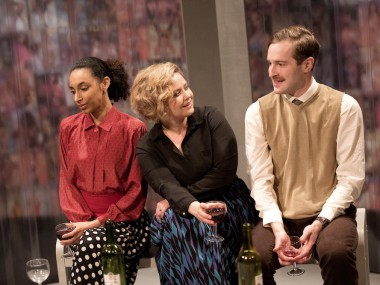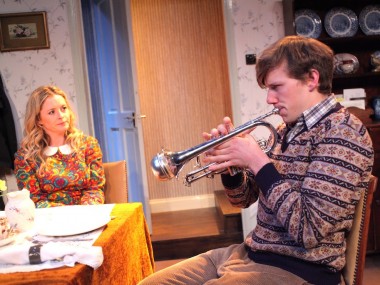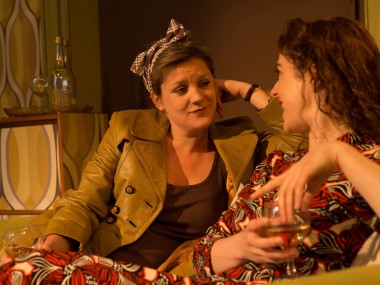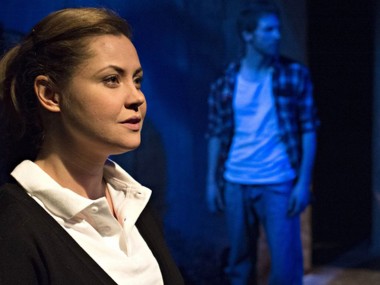Why Is John Lennon Wearing a Skirt? Finborough Theatre
Sunday 15th June 2025
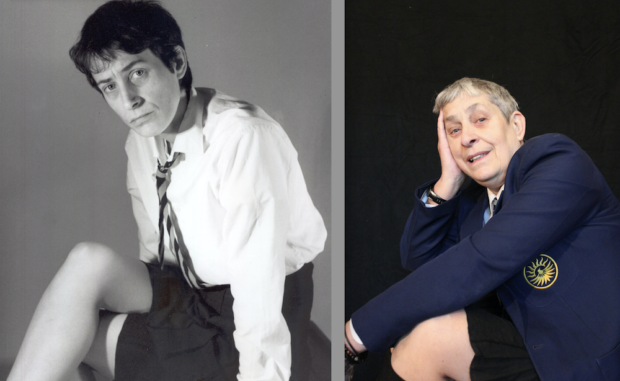
Let us always remember the pioneers. Although there is a fair amount of relatively mainstream queer theatre today (fueled in the popular imagination by RuPaul’s Drag Race on BBC television), things were not always so hunky-dory. When alternative theatre-maker Claire Dowie started her career, in the late 1980s, her stand up shows about gender, sexuality and mental health was innovative, daring and dangerous. Now this legendary performer returns to the Finborough Theatre — “where it all began” — with Claire Dowie’s Swansong, a short season of four plays from four decades.
I remember interviewing Dowie in 1998 about her show Easy Access (for the Boys), a complex in-yer-face play about sex work, child abuse and how victims are often told what they should be thinking and feeling. Now I have the chance to see one of her classics, the irresistibly titled Why Is John Lennon Wearing a Skirt?, which was first staged at the Traverse Theatre, Edinburgh, in 1990, and subsequently at the Finborough, where it won a London Fringe Award a year later. The play was revived for the Edinburgh Festival in 2013, winning a Best of the Fest award, and now returns to the Finborough, one of London’s most remarkable fringe venues.
Dowie’s one-woman show begins with the opening lines of Lennon’s 1971 hit, “Working Class Hero”: “As soon as you’re born they make you feel small.” Yes, that’s where it all originates. Dressed in a blue school uniform, with only an old-style wooden school desk with her on stage, she starts off as a 14-year-old schoolgirl, happy to be part of a gang of tomboys, known as the Fab Four. “Secretly I named my friends Paul, George and Ringo,” she says, “but I never told them (I’m not stupid).” As Lennon, she enjoys a certain moody freedom with them, but having to wear a skirt to school is always a problem — the boys constantly trying to see her knickers.
As Dowie and her friends travel through their teens, she feels even more alienated from the social expectations of femininity as they begin to use make-up, get a good hair-do, wear high heels and act out all the postures of young women, from simpering to agreeing with anything a man says. It’s not for her. It’s too stupid and too demeaning. And, when she goes to the cinema with her boyfriends, what does she see? Films full of “prancing, dancing, semi-naked nymphettes, who you just know are there to titillate and then be attacked”. She rejects these images, and challenges expectations: “I don’t want to be thought of as a tart or a chick or a bird or a doll, a babe, a piece of skirt, bit of crumpet, or even as a nice girl.”
When Dowie goes to work, once again she has problems wearing skirts and having to please male bosses and work mates who buy into these gender stereotypes. Plus there’s the everyday harassment. It’s awful. Then comes women’s liberation, with its own set of expected behaviours. After initially seeing feminism as a great chance to be herself, she soon finds that the other women involved identify mainly with their own oppression. “Fine. Be that then.” Her long list of endless feminist films, plays, cabarets, bands, poets, meetings, discussions, conversations, workshops, seminars, books, pamphlets, posters is both hilarious and a provocative criticism of the middle-class movement of the early 1970s.
Dowie’s 70-minute show packs in a lot of other material about gender expectations. Although we can all agree with the philosopher Judith Butler that our gender identity is something that we perform, so that we have an element of choice about it, it’s also true that we do this in conditions not of our own choosing. This reality is particularly acute in childhood, where choices are decidedly restricted. Paradoxically, Dowie shows how — until secondary school — she enjoyed a great freedom as a tomboy. It’s only later that the skirt problem and the aptly-named “Knicker Factor” begins to impact on her life.
The glory of Dowie’s play is its queerness, the way she convincingly shows how the straight choice between being a boy or being a girl is a gross oversimplification. Reality is much more complicated, more fluid and more diverse. She explores the in-betweeness of gender identity with a focus on personal experience rather than political ideology. This means that she talks frankly about biology — vaginas, wombs, breasts, physical sexuality and pregnancy — but also, and equally frankly, about ideas and beliefs. And the humour of being “John Lennon” while having to wear a dress is beautifully delivered.
Yet despite everything — the sexism, the heteronormativity and the sometimes uncomfortable feelings of being different — this is not a pity party. Dowie shares moments of optimism, as well as powerful resistance, at one point to the sound of Lennon’s “Gimme Some Truth”. There’s certainly an inspirational quality to her performance, which involves challenging social norms by using the hilarity of stand-up comedy, backed by her appealingly strong stage presence. As a performer, she’s fast, funny, warm and delights in the text she’s honed over the years.
Why Is John Lennon Wearing a Skirt? is brilliantly written, using anecdotes, repetition, emphatic points, more repetition, brief pauses, sudden changes of tempo, and yet more repetition — the effect is mesmerizing and very, very entertaining. I really like how Dowie takes the audience into her confidence, then subverts our expectations, then subverts her own stories, then subverts gender stereotypes. Often all at once. She spends the whole show taking off garments that restrict her, that define her, trying out other clothes, from jeans to shorts, discarding heels and dresses, getting help from audience members to cut her tights off with scissors, gradually finding her comfortable wear.
It’s a mix of punky riot and acute critique, which remains as fresh and as relevant today in the age of perfectionist Instagram imagery as it was in the early 1990s. Forcefully directed by Colin Watkeys, similar sentiments can be expected from the rest of her inspired and inspiring work: the other shows in Claire Dowie’s Swansong, which are performed in repertoire, are Adult Child/Dead Child (1987), H to He (I’m Turning into a Man) (2005) and See Primark and Die (Buy Little, Buy Less, Buy Nothing At All) (2010). And although all this sadly feels like a valedictory tour, it is also a tour de force of strong stand up and even stronger personal politics. Wonderful.
This review first appeared on The Theatre Times

